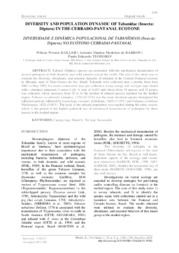Diversity and population dynamic of Tabanidae (Insecta: Diptera) in the Cerrado-Pantanal ecotone.
Diversity and population dynamic of Tabanidae (Insecta: Diptera) in the Cerrado-Pantanal ecotone.
Author(s): KOLLER, W. W.; BARROS, A. T. M. de; TEODORO, P. E.
Summary: Tabanid (Diptera) species are associated with the mechanical transmission of several pathogens to both domestic and wild animals around the world. The aim of this study was to evaluate the diversity, abundance, and seasonal dynamic of tabanids in the Cerrado-Pantanal ecotone in Miranda, state of Mato Grosso do Sul, Brazil. Tabanids were collected once a month, from June 2001 to May 2003, for seven consecutive days per collection, using canopy and nzi type traps baited with a chemical attractant (1-octen-3-ol). A total of 6,492 individuals from 39 species and 18 genera was collected, which increases from 25 to 34 the number of tabanid species reported for the studied region. Tabanus occidentalis Linnaeus, 1758 (62.21%) was the most abundant species throughout the collection period, followed by Lepiselaga crassipes (Fabricius, 1805) (7.19%) and Tabanus sorbillans Wiedemann, 1828 (5.68%). The peak of the tabanid population was reached during the rainy season, which is the period of the highest potential risk of mechanical transmission of pathogens by these insects in the studied region.
Publication year: 2019
Types of publication: Journal article
Unit: Embrapa Beef Cattle
Keywords: Canopy trap, Horsefly, Nzi trap
Observation
Some of Embrapa's publications are published as ePub files. To read them, use or download one of the following free software options to your computer or mobile device. Android: Google Play Books; IOS: iBooks; Windows and Linux: Calibre.
Access other publications
Access the Agricultural Research Database (BDPA) to consult Embrapa's full library collection and records.
Visit Embrapa Bookstore to purchase books and other publications sold by Embrapa.

